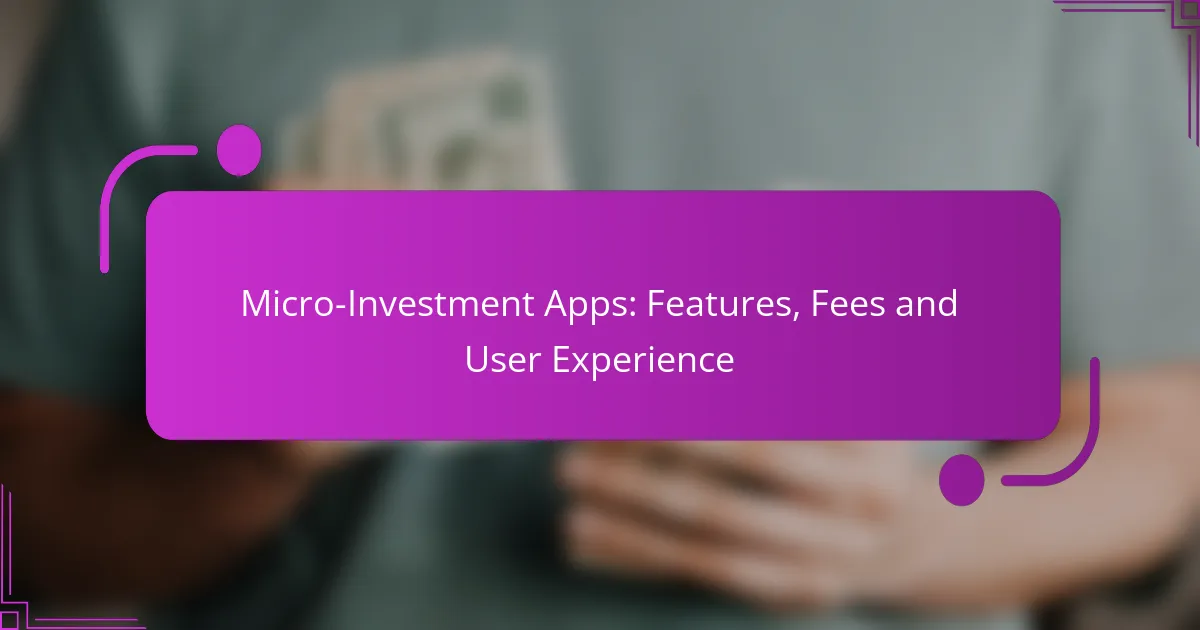Micro-investment apps have revolutionized the way individuals can invest small amounts of money, making it accessible and straightforward for beginners to start building their portfolios. By offering features like automatic round-ups and portfolio customization, these platforms enhance the investing experience while aligning with users’ financial goals. However, it’s essential to be aware of the various fees associated with these apps, as they can significantly affect overall returns.

What are the best micro-investment apps available in the US?
The best micro-investment apps in the US allow users to invest small amounts of money easily and efficiently. These platforms cater to various investment styles and preferences, making it simple for beginners to start building their portfolios.
Acorns
Acorns is designed for users who want to invest their spare change automatically. By linking a debit or credit card, Acorns rounds up purchases to the nearest dollar and invests the difference into a diversified portfolio.
Acorns charges a monthly fee that varies based on the plan chosen, typically ranging from $1 to $5. This fee structure can be beneficial for those who prefer a hands-off approach to investing.
Stash
Stash allows users to start investing with as little as $5, focusing on education and personalized investment options. Users can choose from a variety of stocks and ETFs, making it easy to tailor their portfolios to their interests.
The platform has a monthly fee starting at $1, which includes access to educational resources and investment guidance. Stash is ideal for those who want to learn while they invest.
Robinhood
Robinhood offers commission-free trading for stocks, ETFs, and options, making it a popular choice among young investors. Users can start investing with no minimum balance, allowing for flexibility in investment amounts.
While Robinhood does not charge trading fees, it generates revenue through premium services and interest on uninvested cash. This model is appealing for those who want to trade frequently without incurring costs.
Betterment
Betterment is a robo-advisor that automates the investment process, focusing on long-term growth through diversified portfolios. Users can set financial goals, and Betterment will create a personalized investment strategy based on their risk tolerance.
The platform charges a management fee of around 0.25% to 0.40% of assets under management, which is competitive for robo-advisors. This service is suitable for those looking for a hands-off investment approach with professional guidance.
Wealthfront
Wealthfront is another robo-advisor that offers automated investment management and financial planning tools. Users can start with a minimum investment of $500, and Wealthfront will create a diversified portfolio based on individual risk profiles.
The management fee is typically around 0.25%, and Wealthfront also provides tax-loss harvesting and financial planning features. This makes it a strong option for those seeking a comprehensive investment solution.

What features should you look for in micro-investment apps?
When selecting micro-investment apps, prioritize features that enhance your investing experience and align with your financial goals. Key features include automatic round-ups, portfolio customization, educational resources, and social investing options, each contributing to a more engaging and effective investment journey.
Automatic round-ups
Automatic round-ups allow users to invest spare change from everyday purchases. For example, if you buy a coffee for $3.50, the app can round up the transaction to $4.00 and invest the $0.50 difference. This feature encourages consistent investing without requiring significant effort or large sums of money.
When choosing an app, check if it offers customizable round-up settings, such as the ability to set a specific amount to round up or to exclude certain transactions. This flexibility can help you manage your budget while still growing your investment portfolio.
Portfolio customization
Portfolio customization enables users to tailor their investment choices based on personal preferences and risk tolerance. Many micro-investment apps provide options to select specific sectors, themes, or asset classes, allowing for a more personalized investment strategy.
Consider apps that offer a variety of investment options, such as stocks, ETFs, or socially responsible investments. This variety can help you align your portfolio with your values and financial objectives, enhancing your overall investment experience.
Educational resources
Educational resources are essential for users who want to improve their investment knowledge. Many micro-investment apps provide articles, videos, and tutorials that cover fundamental concepts, market trends, and investment strategies.
Look for apps that offer interactive tools or quizzes to reinforce learning. Engaging with these resources can help you make informed decisions and better understand the implications of your investment choices.
Social investing options
Social investing options allow users to follow and replicate the investment strategies of experienced investors. This feature can be particularly beneficial for beginners who may feel overwhelmed by the complexities of investing.
When exploring social investing features, check if the app provides a community platform where users can share insights and strategies. Engaging with a community can enhance your learning experience and provide valuable support as you navigate your investment journey.

What are the fees associated with micro-investment apps?
Micro-investment apps typically charge various fees that can impact your overall returns. Understanding these fees, including monthly subscription fees, transaction fees, and management fees, is crucial for making informed investment decisions.
Monthly subscription fees
Many micro-investment apps offer subscription models that charge users a monthly fee for access to premium features or services. These fees can range from a few dollars to around $10 per month, depending on the app’s offerings. It’s essential to evaluate whether the benefits provided justify the cost.
Some apps may offer a free tier with limited features, allowing users to test the platform before committing to a subscription. Always check for any promotional offers that might reduce or waive these fees for the initial months.
Transaction fees
Transaction fees are charges incurred each time you buy or sell investments through the app. These fees can vary significantly, with some apps offering commission-free trading while others may charge a flat fee or a percentage of the transaction amount. Typically, these fees can range from $0 to a few dollars per transaction.
Be aware that frequent trading can lead to higher cumulative transaction costs, which may erode your investment gains. Look for apps that provide transparent fee structures and consider how often you plan to trade when choosing a platform.
Management fees
Management fees are ongoing charges for the services provided by the app, often calculated as a percentage of your total investment. These fees usually range from 0.25% to 1% annually, depending on the app and the level of service offered. Lower management fees can significantly enhance your long-term returns.
Some micro-investment apps may offer lower fees for larger investment amounts or provide tiered pricing based on your investment level. Always review the fee schedule and consider how these costs will affect your overall investment strategy.

How do micro-investment apps enhance user experience?
Micro-investment apps improve user experience by simplifying the investment process, making it accessible to a broader audience. They typically offer intuitive features that cater to both novice and experienced investors, allowing users to invest small amounts easily.
User-friendly interfaces
Micro-investment apps are designed with user-friendly interfaces that prioritize simplicity and ease of navigation. This allows users to quickly understand how to invest, track their portfolios, and access educational resources. Features like guided tutorials and interactive dashboards help demystify investing for beginners.
For example, many apps utilize visual aids such as charts and graphs to represent investment performance, making it easier for users to grasp their financial status at a glance. This straightforward approach encourages users to engage more frequently with their investments.
Real-time tracking
Real-time tracking is a key feature of micro-investment apps that enhances user experience by providing up-to-the-minute information on portfolio performance. Users can monitor their investments as market conditions change, allowing for timely decision-making. Notifications about significant market movements or account updates keep users informed and engaged.
Many apps offer mobile notifications and alerts, which help users stay connected to their investments without needing to log in constantly. This immediacy fosters a sense of control and involvement in their financial journey.
Personalized recommendations
Personalized recommendations in micro-investment apps tailor investment options to individual user profiles, preferences, and risk tolerances. By analyzing user behavior and financial goals, these apps suggest suitable investment opportunities, making it easier for users to make informed choices.
For instance, if a user shows interest in sustainable investing, the app may highlight eco-friendly funds or stocks. This customization not only enhances user satisfaction but also encourages users to explore investment avenues they might not have considered otherwise.

What are the prerequisites for using micro-investment apps?
To use micro-investment apps, users typically need to meet certain requirements, including age restrictions, the ability to link a bank account, and minimum investment thresholds. Understanding these prerequisites can help potential users prepare for a smooth onboarding experience.
Age requirements
Most micro-investment apps require users to be at least 18 years old to create an account. This age limit aligns with legal regulations regarding financial transactions and investments. Some apps may allow users younger than 18 to invest with parental consent, but this is less common.
It’s essential to check the specific age policies of the app you are considering, as they can vary. For instance, some platforms may have different rules for custodial accounts aimed at minors.
Bank account linkage
Linking a bank account is a crucial step for using micro-investment apps, as it allows users to deposit funds and withdraw earnings. Most apps require a checking or savings account from a recognized financial institution to facilitate these transactions.
Users should ensure that the bank account they intend to link is in their name and that they have access to online banking. This process usually involves verifying small test deposits made by the app to confirm ownership.
Minimum investment amounts
Micro-investment apps often have low minimum investment requirements, making them accessible for new investors. Many platforms allow users to start investing with as little as $5 to $10, encouraging participation without significant financial commitment.
However, some apps may impose minimum amounts for specific investment options or portfolios. It’s advisable to review these requirements to understand how much you need to invest initially and for subsequent contributions.



